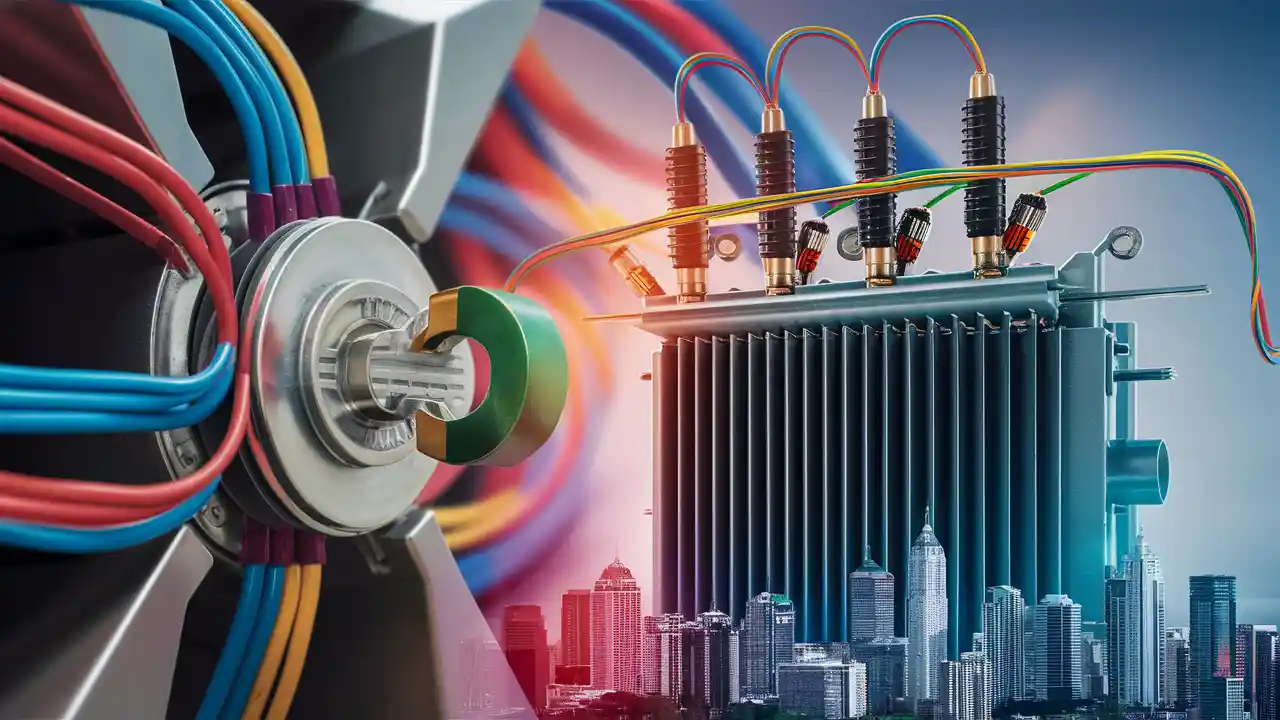Ever wondered how electricity magically jumps from one coil to another inside a transformer without any wires connecting them?
That’s magnetic coupling at work.
What is magnetic coupling in transformer? It’s the process where electrical energy transfers between two circuits through a shared magnetic field—no direct electrical connection needed. Think of it as wireless power transfer that’s been around since the 1800s.
And here’s the kicker:
Without magnetic coupling, we wouldn’t have the power grid as we know it. No efficient voltage transformation. No safe electrical distribution to your home.
In this guide, as a professional magnetic coupling manufacturer, I’ll show you exactly how magnetic coupling works, why it matters, and how engineers optimize it for maximum efficiency.
Let’s dive in.

How Magnetic Coupling Actually Works
Here’s the deal:
Magnetic coupling is based on electromagnetic induction—a principle discovered by Michael Faraday way back in 1831.
But instead of getting all theoretical, let me break it down into simple steps:
Step 1: Primary Winding Gets Energized
When you apply alternating current (AC) to the transformer’s primary winding, something interesting happens.
The current creates a magnetic field around the coil. And because it’s AC, this magnetic field constantly changes—expanding and collapsing 60 times per second (in the US).
Step 2: Core Concentrates the Magnetic Field
Now, here’s where it gets clever.
The transformer core (usually made of laminated steel) acts like a magnetic highway. It captures the magnetic field from the primary winding and channels it toward the secondary winding.
Without the core? You’d lose most of your magnetic field to the surrounding air. Not good for efficiency.
Step 3: Secondary Winding Picks Up the Field
As the concentrated magnetic field passes through the secondary winding, it induces a voltage.
This is Faraday’s law in action: a changing magnetic field creates an electric field.
The result? Electrical energy transfers from primary to secondary without any physical connection.
Pretty cool, right?
The Science Behind the Magic (Without Getting Too Nerdy)
Let’s talk about what makes magnetic coupling tick.
Coupling Coefficient: The Efficiency Score
Engineers use something called the coupling coefficient (k) to measure how well magnetic coupling works.
It’s simple:
- k = 1 means perfect coupling (100% of magnetic flux transfers)
- k = 0 means no coupling at all
Real-world transformers? They typically achieve k = 0.95 to 0.99.
That remaining 1-5% is what we call leakage inductance—magnetic flux that escapes and doesn’t contribute to energy transfer.
Mutual Inductance: The Coupling Strength
Mutual inductance measures how much voltage one coil induces in another.
Higher mutual inductance = stronger magnetic coupling = better transformer performance.
Engineers maximize mutual inductance by:
- Using high-permeability core materials
- Minimizing the air gap in the core
- Optimizing coil placement and winding techniques
Why Magnetic Coupling Matters More Than You Think
You might be wondering:
“OK, but why should I care about magnetic coupling?”
Here’s why:
1. Electrical Safety
Magnetic coupling provides complete electrical isolation between circuits.
Your phone charger? It uses magnetic coupling to safely step down 120V AC to 5V DC without any risk of high voltage reaching your device.
No magnetic coupling = potential shock hazard.
2. Voltage Transformation
Power plants generate electricity at around 20,000 volts. But your home needs 120/240 volts.
Magnetic coupling in transformers makes this voltage conversion possible—and efficient.
Without it? We’d need massive, inefficient resistor networks that would waste most of the energy as heat.
3. Power Grid Efficiency
The entire power grid relies on magnetic coupling.
Step-up transformers at power plants. Step-down transformers in your neighborhood. Even the transformer on the pole outside your house.
All use magnetic coupling to efficiently move electricity from generation to consumption.
Real-World Applications You See Every Day
Magnetic coupling isn’t just transformer theory. It’s everywhere.
Wireless Phone Charging
That charging pad for your smartphone? It uses the same magnetic coupling principle as transformers.
The charging pad has a primary coil. Your phone has a secondary coil. Place them together, and boom—wireless power transfer through magnetic coupling.
Electric Vehicle Charging
Some EVs now support wireless charging using inductive coupling (another name for magnetic coupling).
Park over a charging pad, and your car charges without plugging in. Same transformer principle, just scaled up.
Medical Implants
Pacemakers and cochlear implants use magnetic coupling to transfer power and data through the skin.
No wires breaking the skin barrier = reduced infection risk.
How to Optimize Magnetic Coupling (For the Engineering-Minded)
Want to maximize magnetic coupling in transformer design? Here’s what the pros do:
1. Choose the Right Core Material
Silicon steel is the go-to for most power transformers. Why?
- High magnetic permeability (channels flux efficiently)
- Low hysteresis loss (less energy wasted)
- Cost-effective for large-scale production
For high-frequency applications? Ferrite cores work better.
2. Minimize Air Gaps
Even tiny air gaps in the core create huge magnetic resistance.
That’s why transformer cores use techniques like:
- Precision-cut laminations
- Overlapping joints
- Vacuum impregnation to fill microscopic gaps
3. Optimize Winding Configuration
How you arrange the windings matters—a lot.
Interleaved windings (alternating primary and secondary layers) provide better coupling than separate bobbin designs.
The trade-off? More complex manufacturing and potential isolation concerns.
4. Control Leakage Inductance
Some leakage inductance is inevitable. But you can minimize it by:
- Keeping windings close together
- Using toroidal (doughnut-shaped) cores
- Implementing bifilar winding techniques
Common Problems That Hurt Magnetic Coupling
Even well-designed transformers can suffer from poor magnetic coupling. Here’s what to watch for:
Core Saturation
Push too much current through the primary winding, and the core saturates.
Result? The core can’t carry any more magnetic flux, coupling efficiency drops, and the transformer overheats.
Mechanical Vibration
Loose laminations or poor mechanical assembly cause vibrations.
These vibrations create varying air gaps, reducing coupling efficiency and causing that annoying transformer hum.
Temperature Effects
High temperatures reduce the core’s magnetic properties.
That’s why transformer ratings always specify maximum operating temperature. Exceed it, and magnetic coupling suffers.
Measuring Magnetic Coupling Performance
How do engineers verify magnetic coupling efficiency? Several methods:
Open Circuit Test
Apply rated voltage to the primary with secondary open. Measure the current draw.
Lower current = better magnetic coupling (less energy wasted in core losses).
Short Circuit Test
Short the secondary and apply reduced voltage to the primary until rated current flows.
This test reveals leakage inductance and winding resistance—key factors affecting coupling efficiency.
Coupling Factor Measurement
Use an LCR meter to measure primary inductance (L1), secondary inductance (L2), and mutual inductance (M).
Calculate k = M/√(L1×L2)
Higher k = better coupling.
The Future of Magnetic Coupling Technology
Magnetic coupling technology isn’t standing still. Here’s what’s coming:
High-Temperature Superconductors
Imagine transformer windings with zero electrical resistance.
That’s the promise of superconducting transformers—near-perfect magnetic coupling with minimal losses.
Already in testing for grid applications in 2025.
Wide Bandgap Semiconductors
New materials like silicon carbide (SiC) and gallium nitride (GaN) enable higher-frequency operation.
Higher frequency = smaller transformers with equivalent magnetic coupling.
Your laptop charger is about to get a lot smaller.
Smart Transformers
Digital monitoring of magnetic coupling parameters in real-time.
Detect problems before they cause failures. Optimize performance based on load conditions.
The grid is getting smarter, and magnetic coupling monitoring is part of it.
Practical Tips for Working with Transformers
Whether you’re a student, engineer, or just curious, here are some practical insights:
Safety First
Transformers can store energy in their magnetic field even after power is removed.
Always discharge transformers properly before handling.
Listen for Problems
A healthy transformer hums quietly at line frequency (60 Hz in US, 50 Hz in Europe).
Loud buzzing, crackling, or irregular sounds? That’s often a magnetic coupling problem.
Check the Specs
When selecting transformers, look beyond just voltage ratings.
Check the coupling coefficient, leakage inductance, and efficiency ratings. These tell you how well the magnetic coupling performs.
The Bottom Line
What is magnetic coupling in transformer? It’s the invisible force that makes our entire electrical infrastructure possible—transferring power through magnetic fields without direct electrical connection.
From the massive transformers at power substations to the tiny ones in your phone charger, magnetic coupling quietly does its job millions of times per second.
Understanding magnetic coupling helps you appreciate the elegant engineering in everyday devices. It’s wireless power transfer that predates WiFi by over a century.
And as technology advances—from wireless EV charging to superconducting power grids—magnetic coupling remains at the heart of electrical energy transfer.
Pretty amazing for a principle discovered nearly 200 years ago, right?
The next time you plug in any device, remember: there’s probably a transformer inside using magnetic coupling to keep you safe while delivering exactly the voltage you need.
That’s the power of magnetic coupling in transformers.



